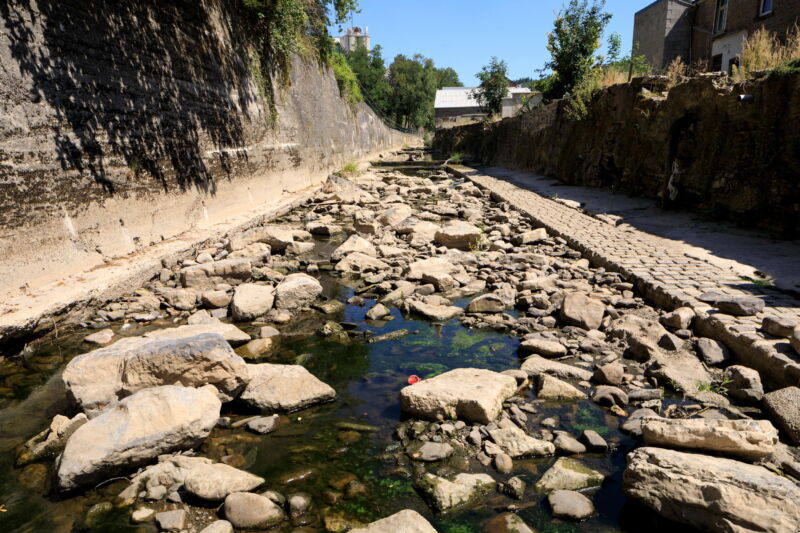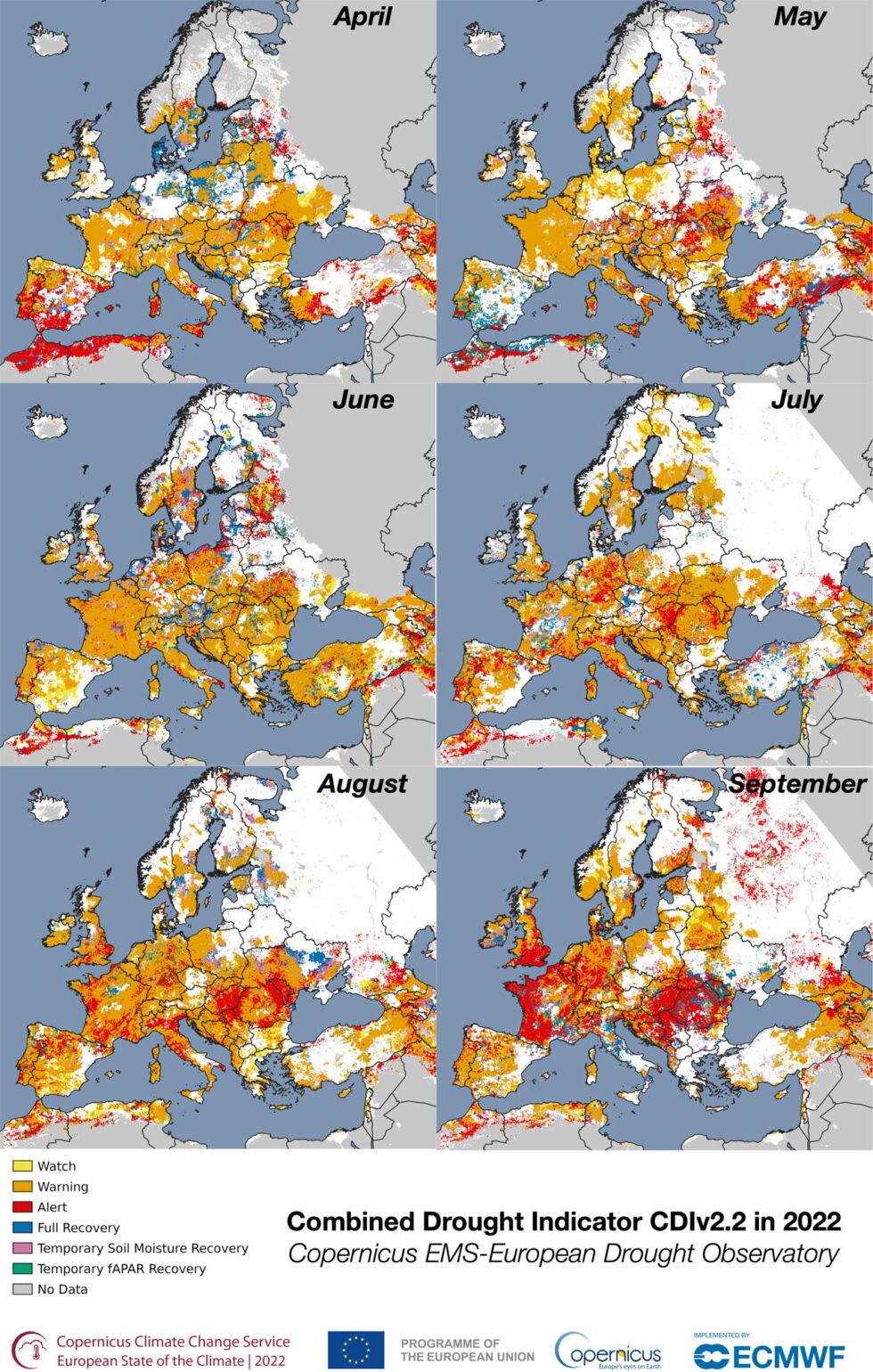
The Arctic Ocean is mostly enclosed by the coldest parts of the Northern Hemisphere’s continents, ringed in by Siberia, Alaska and the Canadian Arctic, with only a small opening to the Pacific through the Bering Strait, and some narrow channels through the labyrinth of Canada’s Arctic archipelago.
But east of Greenland, there’s a stretch of open water about 1,300 miles across where the Arctic can pour its icy heart out to the North Atlantic. Those flows include increasing surges of cold and fresh water from melted ice, and a new study in the journal Weather and Climate Dynamics shows how those pulses can set off a chain reaction from the ocean to the atmosphere that ends up causing summer heatwaves and droughts in Europe.
The large new inflows of fresh water from melting ice are a relatively new ingredient to the North Atlantic weather cauldron, and based on measurements from the new study, a currently emerging “freshwater anomaly” will likely trigger a drought and heatwave this summer in Southern Europe, said the study’s lead author, Marilena Oltmanns, an oceanographer with the United Kingdom’s National Oceanography Centre.
She said warmth over Greenland in the summer of 2023 melted a lot of ice, sending more freshwater toward the North Atlantic. Depending on the exact path of the influx, the findings suggest that, in addition to the immediate impacts this year, it will also trigger a heatwave and drought in Northern Europe in a more delayed reaction in the next five years, she said.
AdvertisementThe coming extremes will probably be similar to the European heatwaves of 2018 and 2022, she added, when there were huge temperature spikes in the Scandinavian and Siberian Arctic, as well as unusual wildfires in far northern Sweden. That year, much of the Northern Hemisphere was scorched, with “22 percent of populated and agricultural areas simultaneously experiencing heat extremes between May and July,” according to a 2019 study in Nature.
In 2022, persistent heat waves across Europe from May to August killed more than 60,000 people, subsequent research showed. The United Kingdom reported its first-ever 40° Celsius (104° Fahrenheit) reading that summer, and the European Union’s second-worst wildfire season on record burned about 3,500 square miles of land.
Meanwhile, 2022 was also Europe’s driest year on record, with 63 percent of its rivers showing below-average discharge and low flows hampering important river shipping channels as well as power production.

Oltmanns said the findings will help farmers, industries, and communities to plan ahead for specific weather conditions by developing more resilient agricultural methods, predicting fuel demand and preparing for wildfires.
Changing effects of freshwater flows into the North Atlantic had previously been observed over decadal timescales, associated with cyclical, linked shifts of ocean currents and winds, but that was “a very low frequency signal,” she said. “We have disentangled the signals.”
Now the fluctuations are more frequent and more intense, “switching between different states very rapidly,” she said, adding that the study shows how the ocean changes driven by freshwater inflows have “direct and immediate consequences on the atmospheric circulation,” and thus on subsequent weather patterns in Europe.
North American links?
Several recent studies already show some of the complex and maybe unexpected ways the North Atlantic and Arctic changes that are documented in the new study affect North American weather and climate patterns. A 2023 paper in Nature Communications, for example, suggests that the rapid decline of spring snowpack across North America promotes the warm and dry weather pattern over Greenland that caused the melting water tracked by Oltmanns.
The changing patterns of fresh versus salty and cold versus warm water masses tied to the melting Arctic ice are shifting major ocean currents, contributing to a long-running ocean heatwave in the Gulf of Maine with potentially devastating impacts on marine life and fisheries. During the last 15 years the Gulf of Maine region has warmed more than seven times as fast as the global average, and faster than 99 percent of the global ocean.
Some research suggests that large new inflows of fresh water into the North Atlantic are already disrupting the system of heat-transporting currents known together as the Atlantic Meridional Overturning Circulation (AMOC), a key Atlantic Ocean current that shunts warm surface water to the Northern Hemisphere and cold, deep water back toward Antarctica. If it weakens a lot or breaks down, it could drive faster sea level rise than currently expected along the East Coast of North America as more warm water accumulates in the region.
A warmer ocean off the East Coast heats the atmosphere above it, and warmer air can carry more moisture, which means more rain when the weather systems sweep inland, like 2011’s Hurricane Irene, which swamped Vermont with destructive and deadly rains, killing seven people and causing $1 billion of damage, and Hurricane Sandy in 2012, which was the largest Atlantic Hurricane on record before it slammed the East Coast.
A growing risk of summer extremes?
The influx of freshwater from melted ice causes a strong temperature difference from the southern to the northern part of the North Atlantic, said Amulya Chevuturi, a hydroclimate data scientist with the UK Centre for Ecology & Hydrology, who was not involved in the study.
AdvertisementThat leads to a more northward flow of warm water in the North Atlantic Ocean, which also pushes the atmospheric jet stream, which steers rainy storms, farther north, “a phenomenon that has long been associated with warmer and drier climate over Europe,” she said.
The findings of the research suggest an increased and growing risk of European summer extremes, but current climate models can’t yet accurately simulate future inflows of freshwater, which makes it hard to make systematic projections, Chevuturi said.
The findings present a huge opportunity for improving seasonal weather predictions for Europe, said Jennifer Francis, a senior scientist with the Woodwell Climate Research Center in Falmouth, Massachusetts.
Francis was not involved in the new study but has done a lot of related research on how the warming Arctic affects mid-latitude weather and climate patterns in densely populated and agriculturally important regions of North America and Europe.
The overall picture of that effect is still not completely clear, she said, but the new research is valuable because it is “focused on one region, so the specific impacts are easier to tease out of the data.”
“The melting Greenland Ice Sheet and additional flow from rivers into the Arctic Ocean are all contributing to the large blob of fresher-than-normal water observed south of Greenland,” she said. The cold blob strengthens the temperature contrasts between different parts of the North Atlantic, which shifts the storm-steering jet stream.
The study is a step forward in understanding how global warming drives extremes “because it links the chain of events, from sea ice loss, freshwater influx through ocean currents to the atmospheric circulation … to show them in observations as well as models,” said Daniela Domeisen, who studies the dynamics and predictability of weather and climate extremes, and who was not part of the new research.
Xavier Fettweis, a polar researcher at the University of Liège in Belgium who tracks ice melt in the Arctic, said the new study shows the trend toward drier and sunnier conditions in Europe is not just part of a natural cycle. And he said the results should be understood in relation to the recent observed changes in the AMOC current.
“In most of the thinking, in particular in the general public, a weakening of the AMOC is associated with colder conditions in Europe that could locally dampen the impact of global warming,” he said. But the new paper suggests the contrary, he added. Larger amounts of freshwater moving from the Arctic to Atlantic “could perturb the general circulation in summer favoring heatwave and droughts.”
Bob Berwyn is an Austria-based reporter who has covered climate science and international climate policy for more than a decade. Previously, he reported on the environment, endangered species and public lands for several Colorado newspapers, and also worked as editor and assistant editor at community newspapers in the Colorado Rockies.
This story originally appeared on Inside Climate News.



















